Your support helps us to tell the story
From reproductive rights to climate change to Big Tech, The Independent is on the ground when the story is developing. Whether it’s investigating the financials of Elon Musk’s pro-Trump PAC or producing our latest documentary, ‘The A Word’, which shines a light on the American women fighting for reproductive rights, we know how important it is to parse out the facts from the messaging.
At such a critical moment in US history, we need reporters on the ground. Your donation allows us to keep sending journalists to speak to both sides of the story.
The Independent is trusted by Americans across the entire political spectrum. And unlike many other quality news outlets, we choose not to lock Americans out of our reporting and analysis with paywalls. We believe quality journalism should be available to everyone, paid for by those who can afford it.
Your support makes all the difference.
January and February will see two remarkable planetary alignments, with one of them offering stargazers a chance to witness a celestial spectacle that will not be repeated for another 15 years.
On Friday 24 January and Saturday 25 January, six planets lined in the night sky, in an event that some astronomers refer to as a planetary parade.
Mars, Jupiter, Neptune, Saturn, Uranus and Venus will appear together in a row, although Neptune and Uranus will only be visible with binoculars or a telescope.
The planets will be together in the night sky throughout the rest of January and February. Weather conditions could be challenging this weekend, with heavy cloud cover predicted in the evenings by the Met Office.
Then on 28 February, seven planets will align in a spectacular configuration that will not occur again until the year 2040.

The best time to see the planetary parade in January is during the first couple of hours after the Sun goes down, with Saturn and Venus appearing close to each other in the southwest, Jupiter high overhead and Mars in the east.
The Red Planet will also be reaching “opposition” this month, making its closest approach to Earth in two years. It will therefore appear bigger and brighter in the night sky, making the planetary alignment even more pronounced.
“You’ll have the opportunity to take in four bright planets in a sweeping view,” said Preston Dyches from Nasa’s Jet Propulsion Laboratory.
“Uranus and Neptune are there, too, technically. But they don’t appear as bright planets… These multi-planet viewing opportunities aren’t super rare, but they don’t happen every year, so it’s worth checking it out.”

Astronomers advise people hoping to see the planetary phenomena to go to an area with minimal light pollution and to allow at least 30 minutes to allow vision to adjust to the darkness.
The latest forecasts from the Met Office suggest that the best place to see the planetary alignment on Saturday evening will be in Scotland and southern England, as clear skies are forecast.

